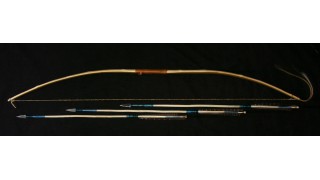Comanche Bow and 3 Arrows circa 1860 (SOLD)
Availability: Out Of Stock
Ex Tax: $0.00
Add to Compare
This replica Comanche bow and set of three arrows is a copy of a set I examined in the Smithsonian several years ago. This set is copied as closely as possible to the original and uses the same materials, construction techniques, and decoration designs. The original bow and arrow was captured from a Comanche warrior in 1868 near Paint Creek, Texas.
This bow is made from a small diameter piece of Osage orange, as was the original. It has a small peg on the upper limb with a tuft of blonde horsehair that's been secured with sinew and glued with hide glue. When unstrung the bow has a graceful gull-wing shape. The nocks are single, and on opposite sides. When viewed from the belly the upper nock is on the left side and the lower nock is on the right. The string is 2-ply twisted sinew, and even has the exact same type of slip knot on the upper loop as the original bow. It still has the sapwood on the back with yellow heartwood on the belly. It is 47 inches long and pulls a stout 42 lbs at 20 inches of draw.
The arrows are also copies of several arrows that were in the original set. They are made of Gray dogwood shoots from Iowa and are fletched with a mix of turkey wing and tail feathers secured with sinew. The wing feathers are placed as the cock feather, just like the originals. The nocks are swallow-tail shaped and flared to aid in using the pinch grip. The fronts of the shafts are tapered and are tipped with somewhat small metal points that are glued with hide glue and wrapped with sinew. There are also teeth marks on the forward 1/3 of the arrows where they were held in the mouth while straightening. The arrows also have three rather straight straightening grooves that begin at the forward fletch sinew wrap and extend all the way to the tip of the shaft. And finally the shafts have been decorated with laundry bluing. They are 27 inches long.
Making this set required a lot of time and research to get it right. The arrows have subtle features (like the tapered fronts and teeth marks) that a lot of replicators miss because they haven't seen the real, original artifacts. They don't make the bow from small saplings like the Comanche commonly did. A lot of the time the bows are too big, the arrows are too long or too bulky, and the paint designs aren't right. This one is spot on, and is worthy of display in a museum. But make no mistake, this isn't just a pretty replica made to sit on a wall...it's a fully functioning and deadly weapon that's designed for hunting. The arrows are matched to this bow, meaning they have been test fired so they fly beautifully. The dogwood arrows are dense and carry a lot of penetrating power. You won't find a more closely matched replica to the original Comanche weapons than this one.
However, because people no longer shoot buffalo from the back of a running horse I deviated from the original artifact in two aspects. First, I glued the feathers to the shaft. Though there were a few Comanche arrows in which the feathers were glued down, most that I examined only had the feathers bound on either end and were not glued. And secondly, I added a leather grip to this bow, even though the original bow didn't have one. The reasons are simple: I prefer hunting arrows to have the feathers glued to the shaft because they're more rigid, so they grab the air and stablize the arrow more quickly when fired. If not, the feathers are pushed sideways when subjected to the extreme wind forces of being shot and their steering qualities are lost. They also flutter in flight, making more noise. The leather grip was added to cushion the arrow and make for a cleaner and quiter release. None of these is necessary if shooting a running buffalo at point blank range as the Comanche once did, but when hunting wary deer in a quiet forest your bow must be as quiet and accurate as possible.
If you're interested in seeing photos of original Comanche artifacts, see my article in the June/July 2010 issue of Primitive Archer Magazine: Treasures of the Smithsonian, Part III: Archery of the Southern Plains: Comanche. I also recommend Bows, Arrows, and Quivers of the Native Americans, Part 2 (Plains and Southwest), by Jim Hamm and Steve Allely.
Write a review
Your Name:Your Review: Note: HTML is not translated!
Rating: Bad Good
Enter the code in the box below:









